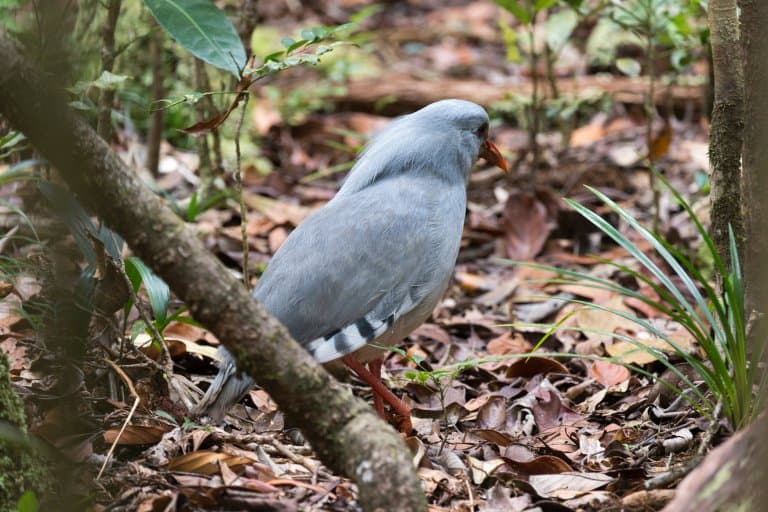Kagu Profile
Island species are often unique, having been isolated from other creatures for millions of years and evolving their own independent traits to fit their specific habitat.
But there’s an island about 1,200km off the coast of Australia that emerged from the ocean 37 million years ago and became the home of one of the lesser-known weirdos of island evolution: the Kagu.
The Kagu (or ‘cagou’) is a flightless, long-legged, crested bird native to the forests of New Caledonia, which is in the southwest Pacific Ocean.

Kagu Facts Overview
| Habitat: | Shaded forest |
| Location: | Grande Terre, New Caledonia |
| Lifespan: | Up to 20 years |
| Size: | 55cm (22 inches) tall |
| Weight: | Around 1kg (2.2lb) |
| Color: | Uniform grey with an orange beak and legs |
| Diet: | Worms |
| Predators: | Rats, dogs, pigs, humans |
| Top Speed: | Unknown |
| No. of Species: | 1 |
| Conservation Status: | Endangered |
Nobody knows exactly where the Kagu came from, or even its closest relatives.
The jury is still out for its specific origin, but it’s the only member of its family, and lives a lonely and threatened existence on an island full of invasive pests.
The kagu is a carnivorous animal that feeds on a range of creatures in the leaf litter of the forest floor, such as annelid worms, snails, and lizards.
It has a couple of unique features and plenty of rare and unusual ones on top.
While it looks plain at first, it’s actually quite a quirky and beautiful bird once given the chance, and though they almost went extinct a few decades ago, a lot of stakeholders are working hard to bring them back from the brink.
Interesting Kagu Facts
1. They’re flightless
While their wings are not reduced in size like many flightless birds, they lack the muscles required for flight and kagu are ground-dwelling birds.
However, they do still use their wings for moving quickly through the forest to evade predators, and using them to glide when necessary.

2. Nose hairs
The name Rhynochetos refers to the nose (rhino) and hairs (chaetae, like the polychaete worm), and draws attention to something most people would like to have ignored.
These hairs are peculiar, as you’ll see are many things about this bird, and they’re thought to protect the nostrils from getting clogged with dirt as the kagu forages for worms.
This is something that no other bird seems to have, but it’s far from the only thing that makes this bird stand out.
3. They evolved with no predators
This has become a bit of a death sentence for many island species, especially birds.
Animals with no threats have no reason to learn to fear strange arrivals, and this means that as people show up with ships, they wander right up to them to investigate.
The Kagu has lost its ability to fly, and potters about fearlessly in the forest undergrowth, though it is capable of running at speed and puffing up when grumpy about something.
Though, this hasn’t been enough to protect them from invaders.
4. The chicks stick around
Kagus are monogamous breeders who form a long-term pair, possibly for life.
They almost always lay a single egg during the breeding season. The mother and father will take shifts of 24 hours to incubate, and then continue the shift work for feeding sessions. Within 14 weeks, the young leaves the nest, but it doesn’t go far.
Offspring of kagus will stay around for up to six years, helping out with the chores.
5. They’re boring, until they open up
This is a very dull-looking bird, and at first glance might slip under your radar as it just stands there, all grey-looking, on the forest floor. But there’s more to them than meets the eye.
First of all, they do have colouration, they just keep it hidden. When the kagu opens its wings – which it does when courting or warning of danger – a vibrant display of blue-black bands transforms it into a vivid display of colour and contrast.
They also have a crest that expands upwards; something which led to them being hunted to make women’s hats.
Then, there are the shouting matches. Males are said to sound something like a cross between a rooster and a dog, and females squabble loudly in short, rapid bursts.
Males and females will combine these tones each morning, for 15 minutes, while spinning; and they’ll do this year-round, to fend off rivals.
They can also hiss and cluck.
Even their feathers are unusual. Kagus have powder downs, which are specialised feathers that produce and powdery substance that cleans and waterproofs their plumage. This isn’t unique to Kagus, but it does add to its niche quality. 1
6. They don’t have weird blood
Kagus were thought to. When their blood was assessed from captive birds, they showed peculiar traits such as a third of the number of blood cells, with the highest haemoglobin concentrations of any birds known.
But when compared with wild samples, this appeared to be an artefact of captivity; all wild samples appeared normal.
Sadly, this suggests a form of anaemia that captive Kagus face, but the good news is that this is invaluable information for breeding programs to have, and should help design healthy diets for captive birds. 2
7. They’re running out of space
Kagus evolved on an island with 70% or more forest cover. When colonists arrived, they set to work doing what they do: cutting down all the trees and digging up the Earth. They flooded the lands and converted it into pasture and ranch.
The first visitors brought dogs, which have further helped reduce Kagu numbers, and today the island has less than 25% forest cover.
By the late ‘70s, there were fewer than 100 left. 3

8. The island pulled together
As the national bird for New Caledonia, the archipelago in which the Kagu lives, its image is everywhere. Yet, with populations so low, it approaches embarrassing that a country would treat its emblem so poorly.
However, as a matter of pride, the islands have begun to put in the work to create protected areas for the Kagu, and have banned the owning of these birds by islanders.
San Diego Zoo is working with the New Caledonian government to create a DNA bank that can be used for future studies, and some successful reintroductions have already taken place.
There are now somewhere between 600 and 1,000 on the island, but two dogs recently wiped out half of the established populations in one location. Dogs remain a serious threat, and the population of kagus is thought to be in decline.
Rats are also a problem, as they will eat the eggs. Conservation projects are focusing on providing safe spaces for the kagu, free from pests and predators, but there’s still a long way to go. 4
Kagu Fact-File Summary
Scientific Classification
| Kingdom: | Animalia |
| Phylum: | Chordata |
| Class: | Aves |
| Order: | Eurypygiformes |
| Family: | Rhynochetidae |
| Genus: | Rhynochetos |
| Species: | Rhynochetos Jubatus |
Fact Sources & References
- Bec Crew (2021), “Meet the ghost of the forest: the rare, flightless kagu“, Australian Geographic.
- Roman Gula, Henri Bloc, Thomas Duval & Jörn Theuerkauf, “Unusual blood profiles in the endemic Kagu of New Caledonia are not physiological“, Springer Link.
- “Rhynochetos Jubatus“, ICUN Red List.
- “Kagu Rhynochetos Jubatus“, San Diego Zoo and Wildlife Alliance.
